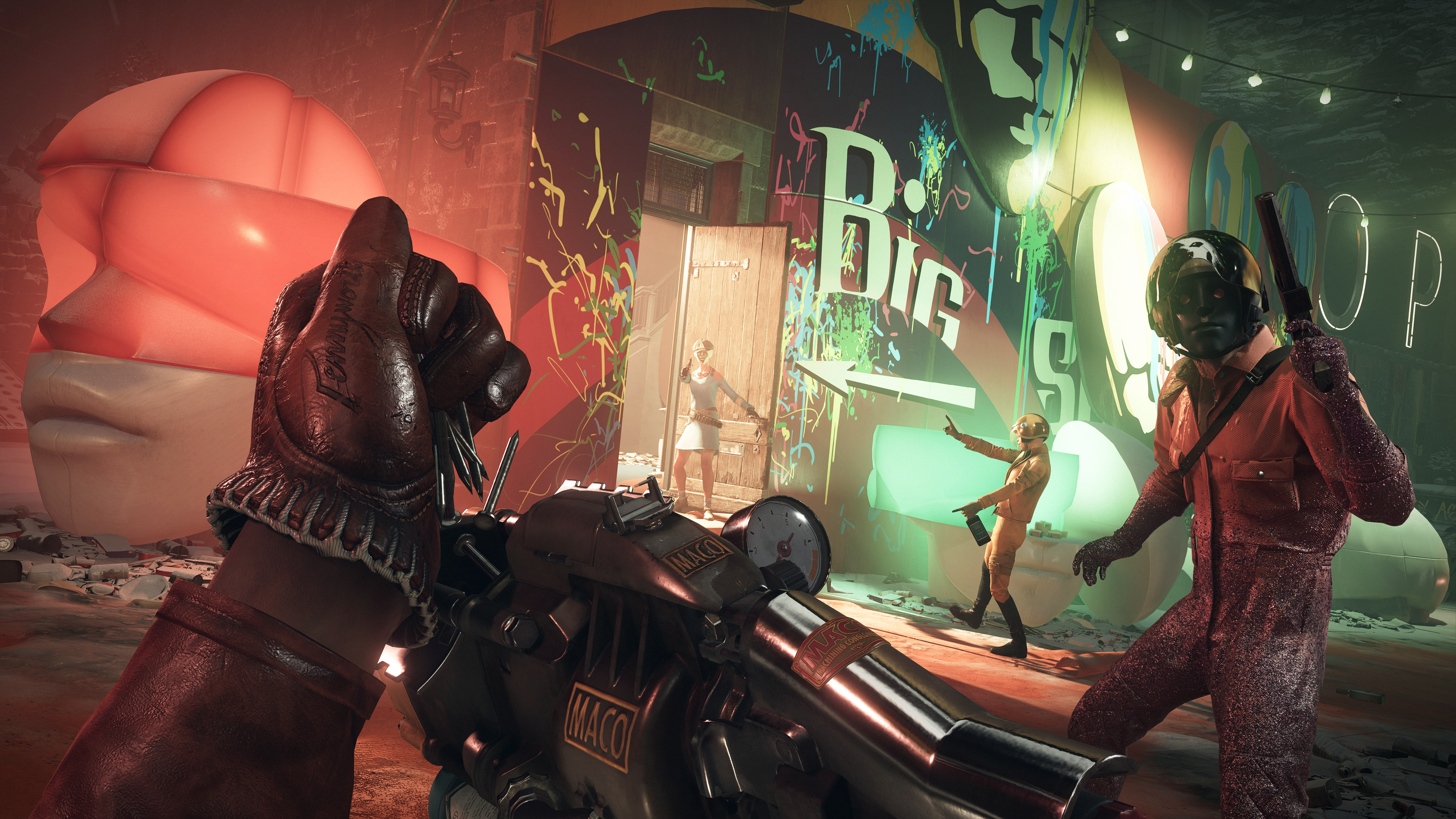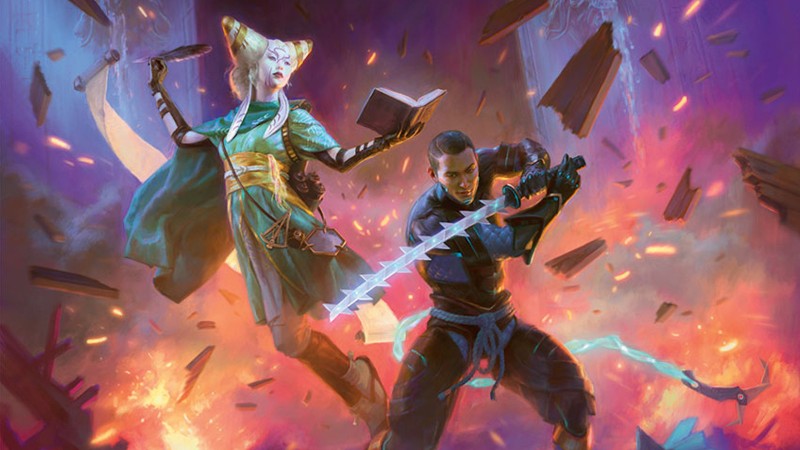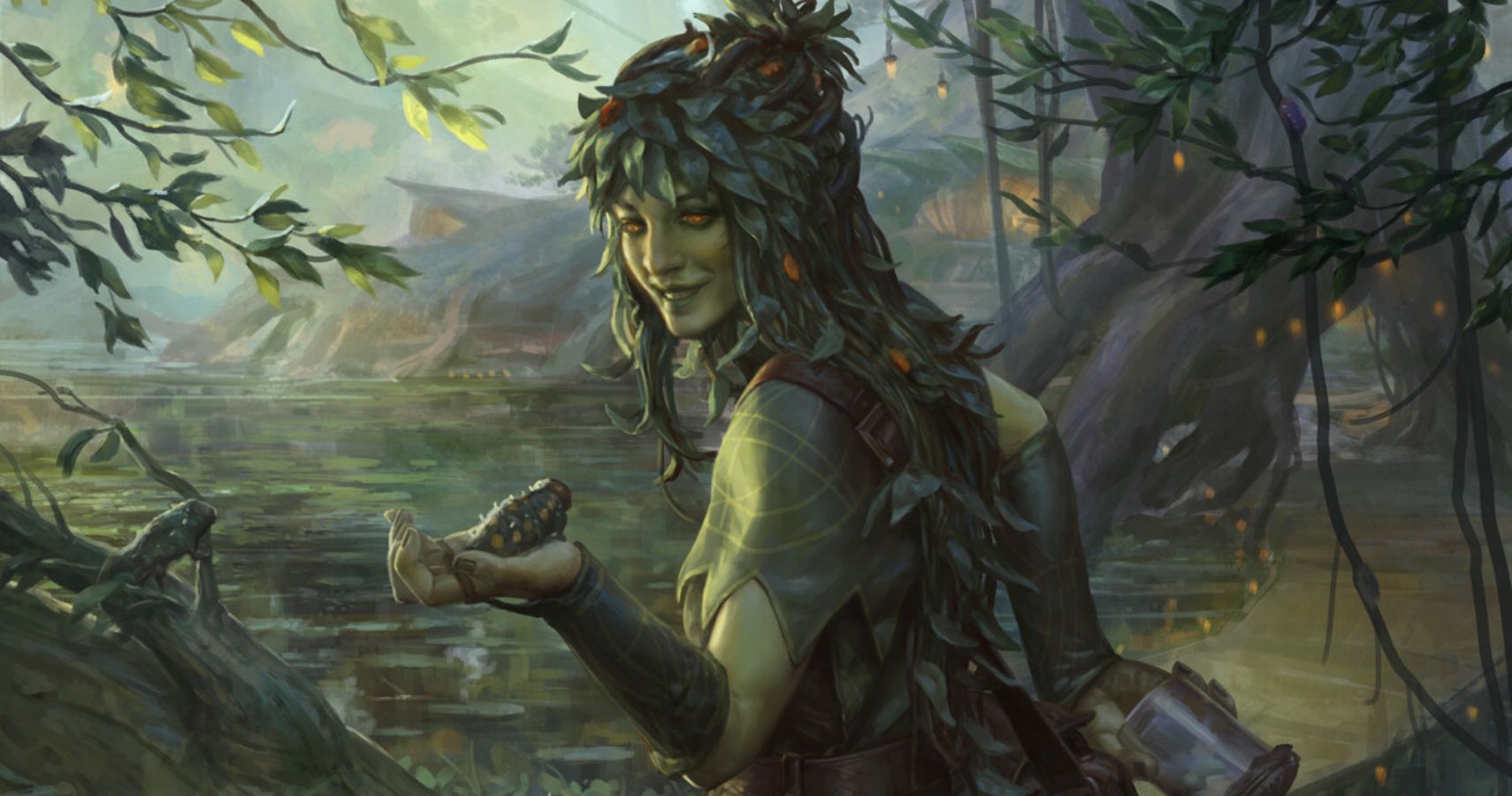
There’s a chunky hand cannon in Deathloop that comes in a variety of styles. My favourite is the one that has the word “Blam!” graffitied on the side – holy hell does it blam. It kicks like Tony Jaa. Blam! Aim down the sights and you can pop skulls with deadly precision, painting the wall behind your target in dark red. Blam! Equip another one in your left hand and you can fire them both at the same time. BLAM! You can fire them independently, too. Blam! Blam!
Developer Arkane is better known for stealth than action, but Deathloop’s action fucking whips ass. You can play the whole thing as a first-person shooter and you won’t be punished for it. I’ve blammed my way through entire levels, running and jumping around, spinning and killing with each trigger pull, kicking enemies over cliff edges, throwing them into the air with telekinetic powers and using them as squishy clay pigeons. Blam!
Related: “At Arkane, There Is This Refusal To Accept That Something Is Impossible” – Deathloop Director
Click in the left thumbstick and, like in most shooters, you sprint. But here, that same motion is how you dodge. Sprint forward and there’s a perceptible burst of speed at the start that sees protagonist Colt Vahn accelerate like a Lambo. Do it sideways and backwards for quick steps, ducking in and out of doorways, running up stairs, jumping out of windows, sliding under gaps, blamming as you go. You’re like a tornado made of bullets, sorcery, and Muay Thai teep kicks.

When I first started playing Deathloop, I played cautiously, creeping up behind masked guards and snapping necks, taking the high ground and finding the safest routes into compounds. When I got comfortable, people got blammed out of existence. Arkane has always given players options to fall back on when stealth fails, but stealth and action live together here in perfect harmony. The structure of the game reinforces this.
You’re stuck in a timeloop with eight targets to kill in a single day. When the day ends or you die, you’re thrown back to the start. It might sound irritating on paper, but even when you fail, you generally achieve something that works towards the end goal: you find a code for a door, which you remember between loops; you figure out a way to make two of your targets meet so you can get them both at the same time; or you find a new weapon or power that will make your life easier. I’ve always said that the best way to play Dishonored, Arkane’s previous series, is to live with your mistakes – too many people get caught up in chasing the perfect run, reloading a save whenever they’re spotted. That’s not an option here because there are no manual saves at all. If you fuck up, it’s time to pull out the guns. Blam or be blammed.
Not only does this solve the save-scumming problem most stealth games have, but it also makes stealth more tense. If you get spotted, you have to shoot your way out or escape and try again. It keeps you away from loading screens and focused on the game.

That tension is compounded by Julianna Blake, one of your eight targets. Julianna can invade your game at any time – once per loop – and it’s usually at the most inconvenient moment possible. In the preview build, she’s controlled by AI, but you have the option to allow other players to take control of her when the game launches. Kill her and you get a bunch of rewards, even replenishing your Reprises (essentially two extra lives per run), but she doesn’t go down without a fight, and she’s as well equipped as Colt. When she joins, a siren song rings out and it’s impossible to not shit your pants just a little bit. When she’s hunting you, it feels like nowhere is truly safe, and it certainly doesn’t help that she can take on the appearance of a normal NPC. Sure, you know none of the vanilla enemies are going to tilt their heads back and look up to the light fixture you’re crouching on, but are you sure that’s not Julianna in disguise?
This invasion mechanic adds a layer of unpredictability to each level, which is vital in a game where knowledge is the ultimate power. By the time the credits roll, you’ll likely know all four environments like your phone PIN, but it’s no easy process. It feels overwhelming at first, but there’s always an objective you can tick off to guide you closer to completion.
You can visit each location at four different times of the day, and areas open up or are blocked off depending on when you visit. Head to Updaam in the daytime and you’ll find a live action game being played across a bridge. Head at night and there’s a mansion party to infiltrate. Arkane heard you like levels, so it put levels in your levels. It’s a lot.

As you learn the layouts of these compounds – these levels within levels, which themselves are actually four levels each – they only grow richer. In one, I entered through the obvious door – in doing so, I was stripped of my powers for reasons I won’t spoil. When I exited, I left through a secret entrance and realised there’s more than one way to blam a cat. I went back on a different day, this time with my powers intact, and it felt like an entirely new place when I was free to teleport around and creep through the rafters.
When I first booted it up, I noticed the things Deathloop doesn’t have – those signature Arkane things. You can’t turn on taps, cooker hobs, or mess about with light switches. There aren’t physics objects all over the place to knock about and stack up. The world is mostly static – a concession to make multiplayer work. At first, I was a little disappointed by this, but once you accept that none of that really matters, the Arkane magic shines through – every location in Deathloop is layered, complex, and you stop missing physics objects the first time you kick someone straight through a window.

It helps that it’s one of the most stylish games I’ve ever played, too. Arkane Lyon has gone from Dishonored 2’s Clockwork Mansion to A Clockwork Orange – or Une Orange Mécanique, as the French would call it. It’s grindhouse gun funk, as if someone took Stanley Kubrick and dragged him through Quentin Tarantino’s filmography – all primary colours and defined lines, all gas masks and bowler hats. Even though you’re in control of the camera, every view feels framed, like there’s an unseen director forcing you to line up the perfect composition. The hyper-real environments contrasted against stylised characters and pop art decor makes you want to explore every single inch of the world, even when you’re being hunted. Hell, I’ve blammed every poor sonofabitch on a level just to be free to walk around and take it all in.
That bold visual style is backed up by some of the best sound design in games. The way Colt’s voice and footsteps echo from the walls of the tunnels that connect Blackreef’s districts together, the smooth jazz that comes in when the action kicks off, the donk of an enemy’s head when their lifeless corpse hits a plastic bin, and the blam of that hand cannon. Deathloop oozes cool.
Next: 23 Fast Facts And Cool Details About Deathloop



